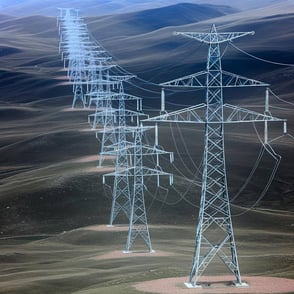Renewables Forecasting
What is Renewables Forecasting?
Renewable energy forecasting is pivotal for integrating sustainable energy sources like solar and wind into the power grid. As the world shifts towards greener energy solutions, the ability to accurately predict the output from renewable energy installations becomes crucial. This forecasting is essential for maintaining grid stability, optimizing energy production, and ensuring efficient operation of energy markets.
How Does Renewables Forecasting Work?
Renewable energy forecasting involves predicting the amount of energy that will be produced by renewable sources in the near future. Just like in load foreasting, predictions are based on various environmental data and sophisticated modelling techniques.
Since renewable energy output is heavily dependent on weather conditions, accurate weather forecasting is fundamental. This includes data on sunlight, wind speed, temperature, cloud cover, and precipitation. Past performance data from renewable energy installations help refine forecasting models by identifying production patterns under different weather conditions. The specific location of renewable energy resources affects their potential energy output due to local weather patterns and geographic features.
Renewables forecasting makes use of multiple techniques. Numerical weather prediction (NWP) models simulate the earth's atmosphere to predict future weather conditions that will impact renewable energy production. Statistical techniques like time series analysis and regression models are used to predict renewable output based on historical weather data and production metrics. Advanced algorithms, including neural networks and decision trees, can analyze large datasets to predict energy outputs with high accuracy, adjusting for nonlinear relationships and complex interactions in the data.
The Impact of Renewables Forecasting on the Energy Sector
The accurate forecasting of renewable energy production has several significant impacts across the energy sector. By predicting when and how much energy will be produced, grid operators can better manage the variability and intermittency of renewable energy sources, maintaining stability and reliability. The forecasting of renewables allows for better management of energy storage systems, deciding when to store excess energy and when to release it to meet demand, thus maximizing the use of renewable resources.
Energy markets benefit from renewables forecasting as it enables more precise energy trading and scheduling, reducing the costs associated with imbalance charges and supplementary reserve power. Long-term forecasting also supports the planning and development of additional renewable energy installations and necessary infrastructure, ensuring that investments align with future energy scenarios.
Despite its importance, renewable energy forecasting faces unique challenges. Firstly, renewable energy sources, particularly wind and solar, are highly dependent on local weather conditions, which can change rapidly. Also, accurate forecasting requires high-quality, granular weather data, which might not always be available, especially in remote locations. The interaction between different weather elements and their impact on renewable energy production can be complex and difficult to model accurately.
Conclusion
Renewable energy forecasting is a crucial component in the transition to a more sustainable energy future. As the adoption of renewable energy grows, the need for precise forecasting will become increasingly important to ensure efficient grid integration and operation. Continued advancements in weather prediction models and machine learning will likely enhance the accuracy and reliability of renewable energy forecasts, supporting the global shift towards sustainable energy solutions.
Glossary
- Renewable Energy Forecasting: The process of predicting the amount of energy that will be generated by renewable sources such as wind and solar power.
- Weather Data: Information related to weather conditions, such as wind speed, sunlight intensity, temperature, cloud cover, and precipitation, which are crucial for predicting renewable energy output.
- Historical Production Data: Past data on how much energy was produced by renewable sources under various conditions, used to improve the accuracy of forecasting models.
- Geographical Information: Data on the specific location of renewable energy installations, which influences their potential energy output due to local weather patterns and geographic features.
- Numerical Weather Prediction (NWP) Models: Advanced computational models that simulate the atmosphere to predict future weather conditions.
- Statistical Methods: Mathematical techniques used to analyze data and identify patterns, often used in forecasting to relate historical conditions to future outcomes.
- Machine Learning: A branch of artificial intelligence that involves training algorithms to recognize patterns in data and make predictions or decisions without being explicitly programmed.
- Grid Management: The process of coordinating the production, distribution, and consumption of electricity within an electricity grid to maintain a balance between supply and demand.
- Energy Storage: Technologies or facilities that store energy produced at one time for use at another time, often used to manage the intermittency of renewable energy sources.
- Market Operations: Activities related to the buying, selling, and trading of energy in the electricity market, including the scheduling of energy production and pricing.
.png?width=200&height=80&name=etpa-logo-color%20(1).png)































.png)
.png)
-1.png?width=250&height=100&name=etpa-logo-color%20(1)-1.png)